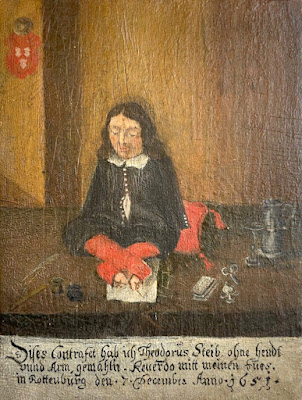– A disabled artist and his self-determined life –
The Object
We [the authors] discovered this miniature self-portrait of Theodorus Steib. It is not just a testament to his painting skills, but also to how he saw himself. His painting skills were truly amazing, and he also managed to capture his experiences as a disabled person in seventeenth-century Austria and Germany.
The picture shows him deep in concentration, sitting on a red cushion on the floor. His gaze is fixed on his feet. As he was born without hands or arms, his feet allowed him to live a self-determined life.
He is shown surrounded by the tools of his trade. Beside him there is an inkwell, an ink blotter, and two quills. By his other side there is a stack of paper with scissors, a drinking vessel, a can and a cut-out object. All these things are expressions of his independence, which show in his professional actions.
The text in the lower section of the picture was written by himself. He described how, when and where he painted the painting.
The content of this contribution is based on extensive research, including contact with different museums, historians and experts. These people enthusiastically helped us and spared no effort in providing us with information from archives and old documents.
This unique and unusual survivor from a bygone era quickly attracted interest. Its existence was unknown for centuries and now that it has been rediscovered, it should be as widely known as possible. It can be viewed on the city website of Rothenburg ob der Tauber. You can also find an article about it here.
Our reasons
The reason for this contribution is a miniature painting, which we bought after discovering it by chance due to our connections in the art world. At first there was no obvious clue which let us know the hidden story this painting tells. After a lot of research many small pieces of information formed a picture of a remarkable and unique life of a person with a disability.
Who was Theodorus Steib?
Theodorus Steib was born in Vienna, during the Thirty Years War (1618-1648). Even as a small child, he was determined to be as independent as possible. Despite social barriers, he painstakingly learned how to use his feet for painting, whittling, cutting paper and cocking and shooting a gun. He also wrote poems and rhymes, mostly about himself.
Historical background
The Thirty Years War was one of the most destructive conflicts in European history and caused widespread hardship. For Theodorus Steib, who was 22 when it ended, his disabilities made things even harder. At the time, disabled babies rarely survived.
At that time, disabled people were often ignored and cast out of society - exhibited at fairs for the amusement of onlookers, or kept as jesters for entertainment at court. Theodorus Steib, however, gained respect and recognition for his abilities. With a cart and three servants, he travelled around the country, bringing his artistic skills to the people.
All this gave him astonishing confidence and the financial means to make a living for his family, his three servants and himself. With persistence, hard work, much courage, and endurance he refined his art. He demonstrated his talents publicly, writing poems or little letters in the presence of viewers. Selling these enabled him to become financially independent and later to support his family.
His journey
The fact that he is preserved in records is testament to the importance that people attached to him.
When he was 24 he travelled from Regensburg to Rothenburg ob der Tauber, where he stayed for a couple of weeks and took part in the Christmas Market as an artist.
He was a visitors’ magnet. There he also penned rhymes and little letters, cut figures with scissors and painted others and himself.
A year later he moved to Nuremberg. Whilst there he painted paintings and penned little letters, to the delight of paying audiences. His financial livelihood was secured.
In July 1657 he married his wife Martha in the Scots Church in Vienna. One year later, his daughter Maria Catharina was born. Two years later his son Georg was born. In the year 1663 he travelled with his family back to the renowned spa town of Baden in Switzerland. Shortly after that Theodorus sadly died. His son Georg followed him a few weeks later.
Addition of 16 August 2023:
The miniature panel painting by Theodorus Steib has been officially and permanently included in the list of "nationally valuable cultural assets" by the Commission for the Protection of Cultural Property in Germany.
___________
About the authors:
Retired married couple.
Centre of life: Rhineland-Palatinate
Interested in ancient artwork.
Hobby: Exploration of histories.
Recommended citation:
Karla-Kreitz (2023): Theodorus Steib (born 1627). In: Public Disability History 8 (2023) 1.



